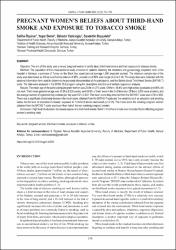| dc.contributor.author | Özpınar, Saliha | |
| dc.contributor.author | Demir, Yaşar | |
| dc.contributor.author | Yazıcıoğlu, Bahadır | |
| dc.contributor.author | Bayçelebi, Saadettin | |
| dc.date.accessioned | 2023-10-02T06:30:42Z | |
| dc.date.available | 2023-10-02T06:30:42Z | |
| dc.date.issued | 2022 | en_US |
| dc.identifier.uri | https://www.scopus.com/record/display.uri?eid=2-s2.0-85140140566&origin=resultslist&sort=plf-f&src=s&nlo=&nlr=&nls=&sid=20c4fe371b9b908d4f7e419f791331ff&sot=aff&sdt=cl&cluster=scofreetoread%2c%22all%22%2ct&sl=72&s=AF-ID%28%22Alanya+Alaaddin+Keykubat+University%22+60198720%29+AND+SUBJAREA%28MEDI%29&relpos=43&citeCnt=1&searchTerm= | |
| dc.identifier.uri | https://hdl.handle.net/20.500.12868/2352 | |
| dc.identifier.uri | https://cejph.szu.cz/artkey/cjp-202203-0003_pregnant-women-s-beliefs-about-third-hand-smoke-and-exposure-to-tobacco-smoke.php | |
| dc.description.abstract | Objective: The aim of this study was to reveal pregnant women’s beliefs about third-hand smoke and their exposure to tobacco smoke. Methods: The population of this cross-sectional study consisted of patients attending the obstetrics and gynaecology outpatient clinic of the hospital in Samsun, a province of Turkey on the Black Sea coast (annual average 4,000 pregnant women). The minimum sample size of the study was determined as 350 at a confidence interval of 95%, prevalence of 50% and margin of error 0.05. The study data were collected with the personal information form used to determine the personal characteristics of the participants, and the Beliefs about Third-Hand Smoke (BATHS-T) scale. The data were analysed in the SPSS 25.0 program using the descriptive statistics and multiple regression analysis. Results: The mean age of the participating pregnant women was 26.84 ± 4.372 years. Of them, 48.4% were high school graduates and 86% did not work. Their mean gestational age was 29.85 ± 9.238 weeks, and 69.8% of them were in the third trimester. Of them, 9.8% were smokers, and the average number of cigarettes they smoked per day was 6.97 ± 4.931. The mean score they obtained from the BATHS-T scale was 3.79 ± 0.859. There was a significant relationship between the mean score obtained from the BATHS-T scale and the variables such as education and smoking status. As the level of education increased, exposure to third-hand smoke decreased (p < 0.05). The mean score the smoking pregnant women obtained from the BATHS-T scale was lower than that of the non-smoking pregnant women. Conclusion: High level of education decreases exposure to third-hand smoke. Belief in third-hand smoke is an important factor affecting pregnant women’s smoking habit. | en_US |
| dc.language.iso | eng | en_US |
| dc.relation.isversionof | 10.21101/cejph.a7063 | en_US |
| dc.rights | info:eu-repo/semantics/openAccess | en_US |
| dc.subject | Pregnant women | en_US |
| dc.subject | Third-hand smoke | en_US |
| dc.subject | Exposure to tobacco smoke | en_US |
| dc.title | Pregnant Women's Beliefs About Third-hand Smoke and Exposure to Tobacco Smoke | en_US |
| dc.type | article | en_US |
| dc.contributor.department | ALKÜ, Fakülteler, Tıp Fakültesi, Temel Tıp Bilimleri Bölümü | en_US |
| dc.identifier.volume | 30 | en_US |
| dc.identifier.issue | 3 | en_US |
| dc.identifier.startpage | 154 | en_US |
| dc.identifier.endpage | 159 | en_US |
| dc.relation.journal | Central European Journal of Public Health | en_US |
| dc.relation.publicationcategory | Makale - Uluslararası Hakemli Dergi - Kurum Öğretim Elemanı | en_US |


















